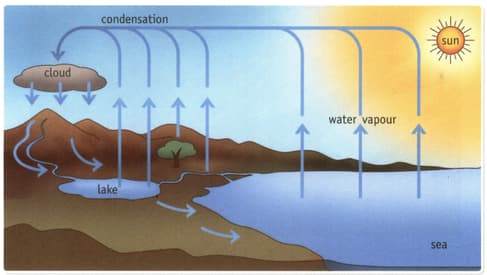Study the diagram of the water cycle. Fill in the blanks.

The water on the Earth keeps changing its _____ in a continuous cycle called the _____. This natural cycle is powered by the _____ from the sun. Large quantities of _____ from the lakes and _____ evaporate into the _____. The water vapour rises up and condenses to form _____. When the water droplets become _____, they fall as drops. This causes _____.

The water on the Earth keeps changing its _____ in a continuous cycle called the _____. This natural cycle is powered by the _____ from the sun. Large quantities of _____ from the lakes and _____ evaporate into the _____. The water vapour rises up and condenses to form _____. When the water droplets become _____, they fall as drops. This causes _____.

Important Questions on Water: A Precious Resource
A and B refer to two different localities in the same town. Study the illustrations carefully and answer the questions. Each small blue circle indicates a tube well.

Do both localities have the same number of houses?
A and B refer to two different localities in the same town. Study the illustrations carefully and answer the questions. Each small blue circle indicates a tube well.

Do both localities have the same number of tube wells?
A and B refer to two different localities in the same town. Study the illustrations carefully and answer the questions. Each small blue circle indicates a tube well.

Which locality has more number of tube wells?
A and B refer to two different localities in the same town. Study the illustrations carefully and answer the questions. Each small blue circle indicates a tube well.

Which locality has less water in its underground source?
How much of the total amount of water is available to us for use?
